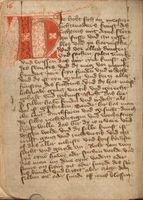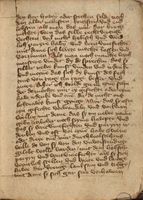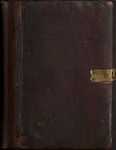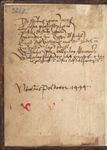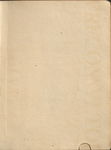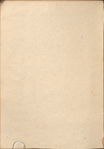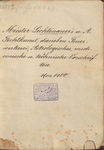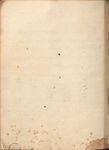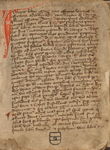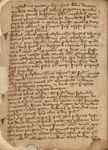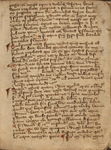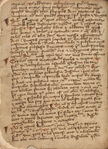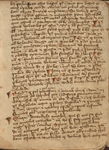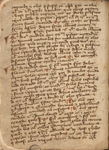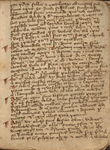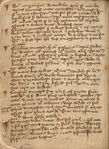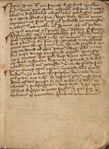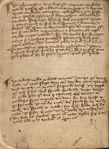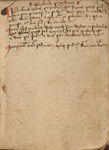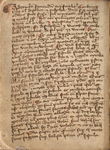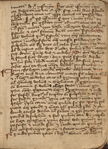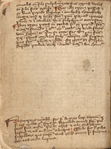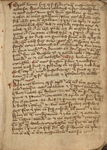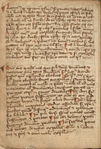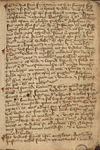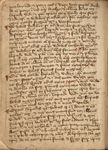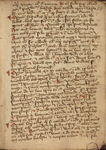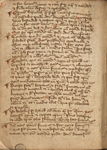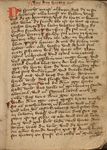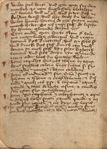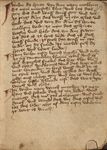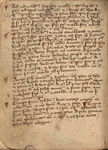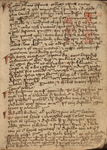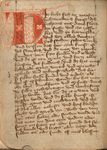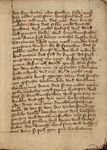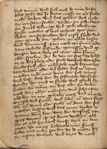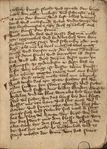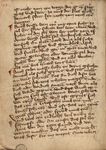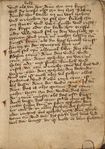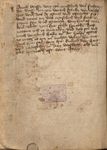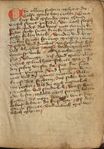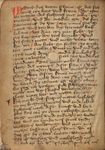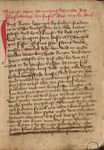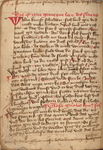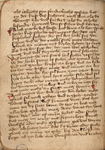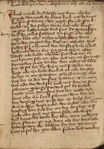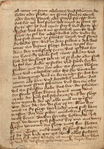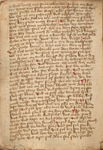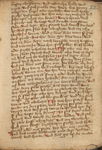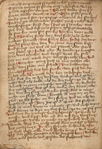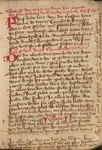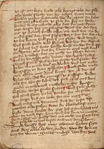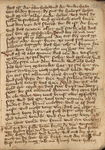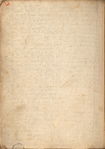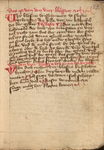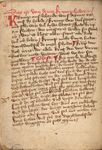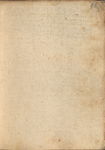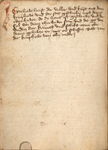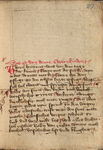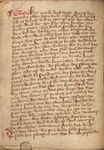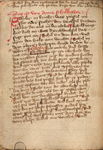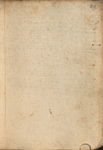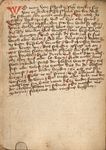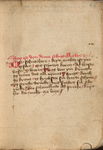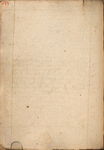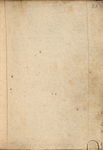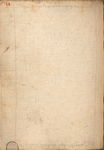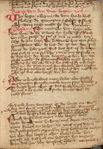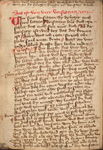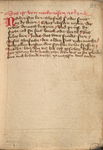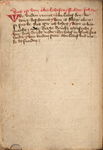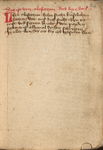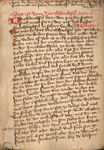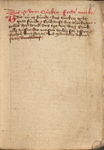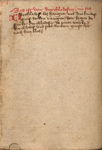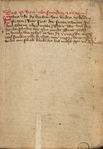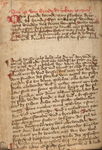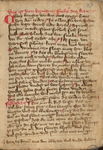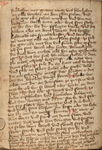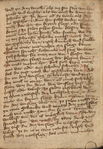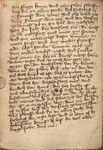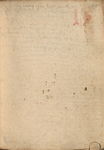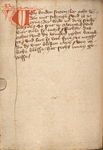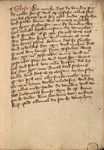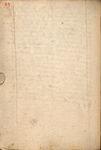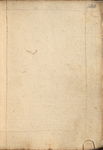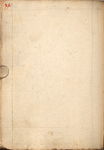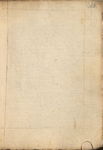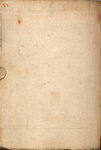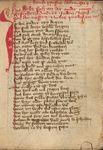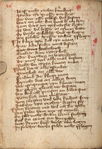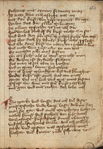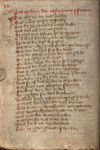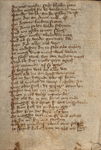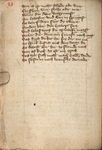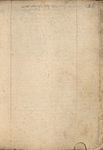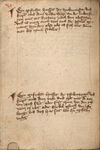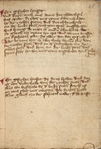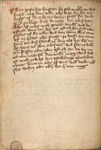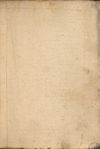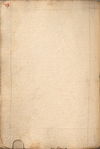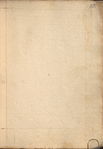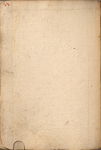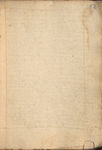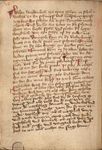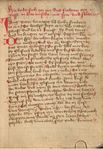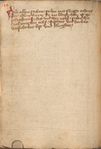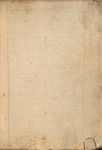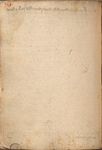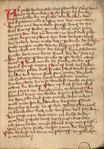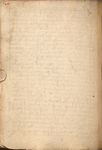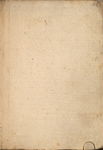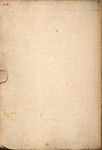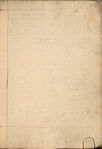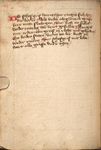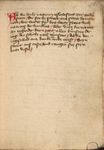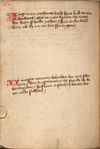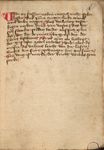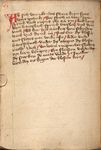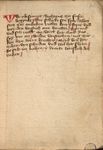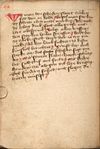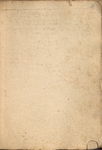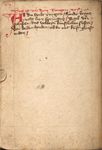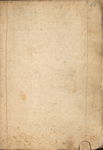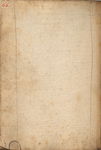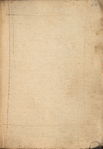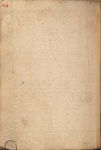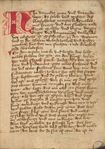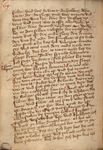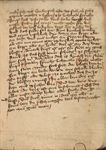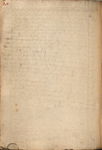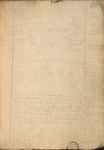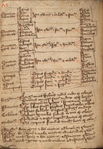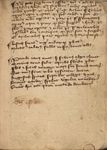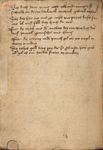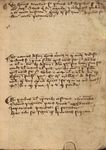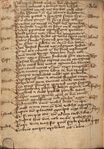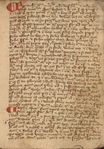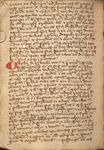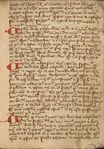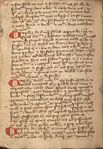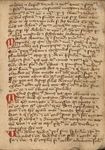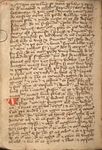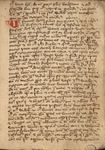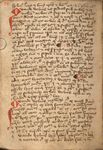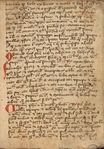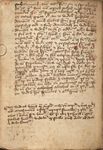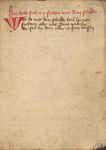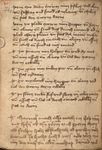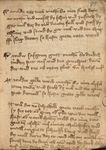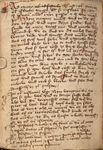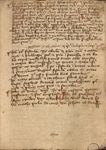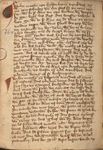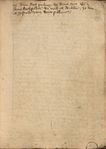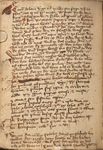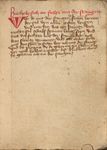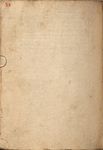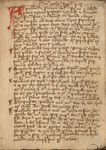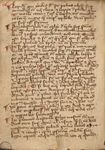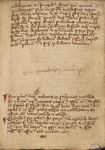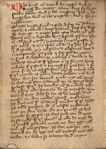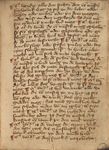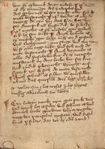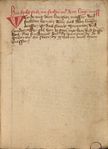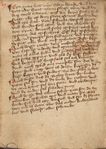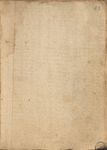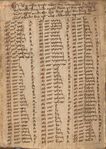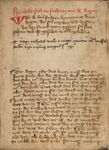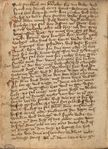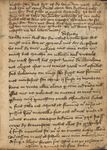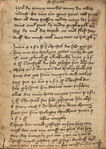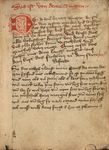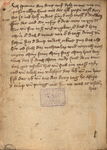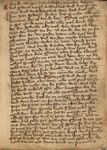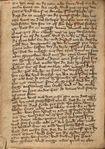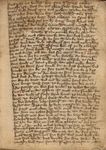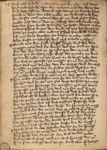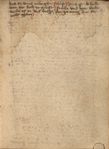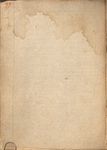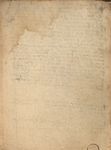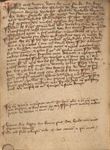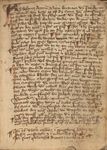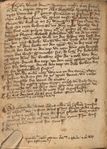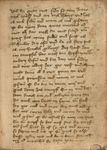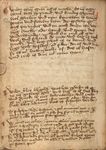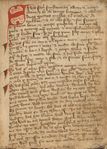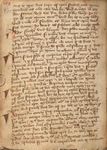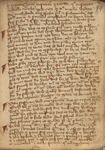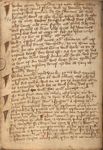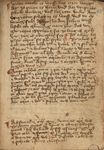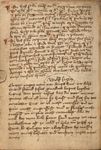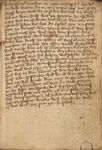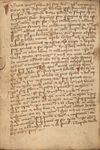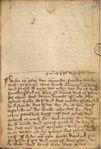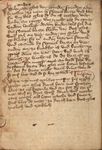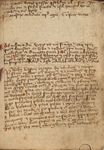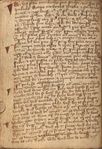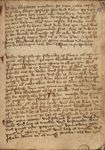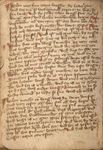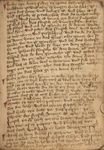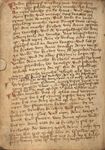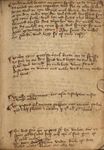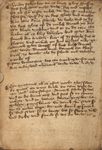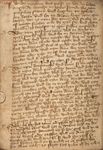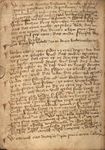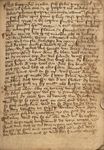The Pol Hausbuch (MS 3227a) is a German commonplace book (or Hausbuch in German) thought to have been created some time between 1389 and 1532.[1] The original currently rests in the holdings of the Germanisches Nationalmuseum in Nuremberg, Germany. It is sometimes erroneously attributed to Hans "Hanko" Döbringer,[2] when in fact he is but one of the four authors of a brief addendum to Johannes Liechtenauer's art of long sword fencing, which is also the only fencing material in the manuscript that appears in any other fencing manual. The rest of the manuscript is a typical example of a commonplace book, containing a variety of unrelated writings on mundane and esoteric topics, including fencing and grappling, but for this reason, the anonymous author of the rest of the fencing material is sometimes known as Pseudo-Hans Döbringer. Pseudo-Döbringer's writings seem to consist of commentary on and expansion of the teachings of Liechtenauer, and it is even speculated that he was still alive at the time of the writing.[3]
Christian Tobler argues that it is unjustified to assume a date of 1389 based purely on the presence of a century-long calendar.[4] The eclectic nature of commonplace books means that the calendar could easily have been an old calendar or even a future one. As the date of the Pol Hausbuch is also used to estimate the time period of Liechtenauer's career, this is a significant error. (Using it to date Liechtenauer is further complicated by the fact that even if he were alive when the fencing treatise was written, the version in this manuscript is potentially a later copy rather than the original.)[5] An upper limit on the origin of the manuscript is often estimated based on the date in the front cover, which seems to indicate that Nicolaus Pol owned it in 1494, but that's a misinterpretation Pol received his doctorate in 1494, and all books from his library follow his name with "Doctor, 1494".
Provenance
Contents
| 1r - 5v
|
Liber Ignium by Marcus Graecus
|
| 5v
|
[edit] Complete Translation 
by Ondrej Vodicka
|
Transcription [edit]
by Ondrej Vodicka
|
In order to see a thousand armed knights in front of you in the field etc., cut off a branch of a willow tree with a single cut and wash it before sunrise in running water for seven days and say: "Gribello, come, you are coming with a thousandfold magnificence, I ask you by Astaroth, that you come with help of thousand-strong force." After you have said this ten times, take the rod and hit the ground three times and say the credo ten times, lift the rod in your hand, and now you can see 100 knights etc. in full armour etc.
|
[5v] ¶ Ut videas mille milites armatis in campo ante te etc. Haw mit eynem slage von eyner weiden eynen czweyk und wasche yn in eynem flissendem wasser VII tage ante ortum solis, und sprich: Gribello, venite, venitis cum mille granditate, quaesso vos per Astaroth, quatenus veniatis cum milleno forte auxilio. Und wen du daz hast X gesprochen so nym dy ruten und slach sy III an dy erde und sprich X credo, czu hant hebe auf dy ruten, zo systu C ritter etc. mit vollem harnüsch etc.
|
If you want them to disappear, throw the rod away on the ground, and the rod has no power anymore etc.
|
¶ Si vis, ut recedant, proice vel iacta virgulam super terram, et tunc nulli plus valebit illa virga etc.
|
|
| 6r
|
Recipes for powders used for painting
|
| 6v - 10v
|
Latin recipes (paint, alchemy, medicine)
|
| 11r - 12r
|
Von dem herten
|
| 12v - 13r
|
Alchemical recipes in Latin
|
| 13v - 17v
|
Fencing advice by Pseudo-Hans Döbringer
|
| 18r - 40r
|
Gloss of Liechtenauer's long sword by Pseudo-Hans Döbringer
|
| 43r - 52v
|
Long sword by Andres Juden, Jobs von der Nyssen, Nicklass Prewßen, and "the Priest" Hans Döbringer
|
| 53r - 59v
|
Recital on mounted fencing by Johannes Liechtenauer
|
| 60r - 61r
|
Recital on short sword by Johannes Liechtenauer
|
| 64r - 65r
|
Conclusion of the teachings of Liechtenauer by Pseudo-Hans Döbringer
|
| 66v - 67r
|
Astrological texts, magical and medicinal recipes, name magic
|
| 67v
|
[edit] Draft Translation 
by Ondrej Vodicka
|
Transcription [edit]
by Ondrej Vodicka
|
So that your enemy can not prevail over you, write on three separate leafs Michael, Gabriel, Raphael.
|
[67v] Daz dich dein veint icht uberbind muczen, so schreib an drew larlawb Michael, Gabriel, Raphael.
|
So that your hair does not fall out, mix some burned flax seed with oil and spread the skin with it.
|
Daz daz har nit auß ge, misch verprent linsat sam mit öl und salb daz haup da mit.
|
And for the sin under the face of the night, put flour mixed with honey on it.
|
Et für dy mail unter dem antlucz dez nachtes, leg dar auf pomnel gemischet mit hönig.
|
And for worms in stomach, put 15 nails in his wine.
|
Et für dy würm in dem pauch gib im XV nagel in wein trinken.
|
Carry the gall of a roe deer with you in order to win the favor of the lord, or put it into the drink of a beautiful lady.
|
Dez rehes gall trag pey dir so gebinstu herren gnad, oder gib es einer czarten fraün in trinken.
|
|
| 68r - 73v
|
Astrological texts, magical and medicinal recipes, name magic
|
| 74r
|
Sword and buckler teachings by Pseudo-Hans Döbringer
|
| 74v - 77v
|
Recipes for paint, tumors, metal and ivory treatment
|
| 78r
|
Staff teachings by Pseudo-Hans Döbringer
|
| 79r - 81v
|
Miscellaneous Latin recipes, treatment of gems, preparation of a miraculous potion
|
| 82rv
|
Messer teachings by Pseudo-Hans Döbringer
|
| 83v
|
Interval between Epiphany and Ash Wednesday for years 1390-1495
|
| 84r - 85r
|
Dagger teachings by Pseudo-Hans Döbringer
|
| 85r - 85v, 86v
|
Magical recipes
|
| 86r, 87r - 89r
|
Grappling teachings by Pseudo-Hans Döbringer
|
| 90v - 91v
|
Medical Recipes for the Mouth and Teeth
|
| 92r
|
[edit] No Translation 
|
Transcription [edit]
by Helmut Werner Klug, et al.
|
|
|
[92r] Wil du guten met siden so nim drew
tayl wasser vnd ain tayl hoenig vnd las
es wol siden vnd wann es wol gesoten
ist So nÿm dann czway viertail oder
mer all dar nach du met seüst vnd
trag das in ein stüben vnd seczt es
?[6] hinder den ofen vnd la es sten pis
es ein hewbel gebingt daz haist dan
ein tampfel dar nach tue hopfen in den
andern hefen vnd laz dan wol siden
vnd rür albeg dar gar vast vnd chum
nicht dauon oder der met prün an vnd
wuerd prv̈nssen vnd[7] wann er wol
gesoten ist So tue in inein vas vnd
geüs dann das tampfl hin in vnd lazz
dann durch ein ander arbayten
|
|
|
Item czu
der varb nim lauttern saym vnd seud
den gar wol vnd ruer den auch albeg
dar mit einem holcz vnd wenn dy varb
wol gesoten ist So versuch sy nim ein pret
lein vnd trapf sy dar auf stent dy tropfen
vnd sind hert so ist sy güt vnd wenn
sy schonn vnd rot ist So geus sy also
haisse in den met vnd la in dann sten acht
tag oder vierczehen So hastu gueten met
|
|
| 92r - 165v
|
Various alchemical recipes, food recipes, nonsense recipes, in various hands
|
| 161v - 165v
|
"Horse pharmacopeia" (Rossarzneibuch) by Master Albrant
|
| 166r - 169v
|
Index to the recipes in the manuscript, partly illegible
|
Gallery
A collation diagram for this manuscript is available on the
index page.
Additional Resources
The following is a list of publications containing scans, transcriptions, and translations relevant to this article, as well as published peer-reviewed research.
- Burkart, Eric (2016). "The Autograph of an Erudite Martial Artist: A Close Reading of Nuremberg, Germanisches Nationalmuseum, Hs. 3227a." Late Medieval and Early Modern Fight Books. Transmission and Tradition of Martial Arts in Europe: 451-480. Ed. by Daniel Jaquet; Karin Verelst; Timothy Dawson. Leiden and Boston: Brill. doi:10.1163/9789004324725_017. ISBN 978-90-04-31241-8.
- Burkart, Eric (2020). "Informationsverarbeitung durch autographe Notizen: Die ältesten Aufzeichnungen zur Kampfkunst des Johannes Liechtenauer als Spuren einer Aneignung praktischen Wissens." Mittelalter. Interdisziplinäre Forschung und Rezeptionsgeschichte S2: 117-158. doi:10.26012/mittelalter-25866.
- Cabreira, Diniz (2018). Há Uma Única Arte da Espada (GNM HS 3227a). Santiago de Compostela: AGEA Editora. ISBN 978-84-948682-6-9.
- Chidester, Michael; Dierk Hagedorn (2021). 'The Foundation and Core of All the Arts of Fighting': The Long Sword Gloss of GNM Manuscript 3227a. Somerville: HEMA Bookshelf. ISBN 978-1-953683-05-2.
- Chidester, Michael (2021). The Long Sword Gloss of GNM Manuscript 3227a. Somerville: HEMA Bookshelf. ISBN 978-1-953683-13-7.
- Ehlert, Trude; Rainer Leng (2003). "Frühe Koch- und Pulverrezepte aus der Nürnberger Handschrift GNM 3227a (um 1389)." Medizin in Geschichte, Philologie und Ethnologie. Königshausen & Neumann. ISBN 978-3826021763.
- Hammer, Maciej (2015). Tłumaczenie traktatu szermierczego zawartego w rękopisie Nürnberger Handschrift 3227a z wyszczególnieniem trudności zaistniałych podczas przekładu [unpublished thesis]. Uniwersytet Jagielloński Wydział Filologiczny.
- Hester, James (2009). "Real Men Read Poetry: Instructional Verse in 14th-century Fight Manuals." Arms & Armour 6(2): 175-183. doi:10.1179/174962609X417590.
- Hull, Jeffrey; Grzegorz Żabiński; Monika Maziarz (2007). Knightly Dueling: The Fighting Arts of German Chivalry. Boulder: Paladin Press. ISBN 978-1-581606744.
- Leng, Rainer (2000). "Andreas der Jude, Jost von der Neißen und Niclas Preuß: Drei verhinderte 'Verfasser' eines Fechtbuches." Würzburger medizinhistorische Mitteilungen 19: 209-220.
- Talaga, Maciej (2022). "'Have the Highest Righteous Fencer in Your Mind's Eye': Medieval Martial Ethic as a Conceptual Repository for Just War Theory." Martial Arts Studies 12: 8-18. doi:10.18573/mas.154.
- Tobler, Christian Henry (2022). Lance, Spear, Sword, & Messer: A German Medieval Martial Arts Miscellany. Wheaton: Freelance Academy Press. ISBN 978-1-937439-64-4.
- Verelst, Karin (2016). "Finding a Way through the Labyrinth: Some Methodological Remarks on Critically Editing the Fight Book Corpus." Late Medieval and Early Modern Fight Books. Transmission and Tradition of Martial Arts in Europe: 117-188. Ed. by Daniel Jaquet; Karin Verelst; Timothy Dawson. Leiden and Boston: Brill. doi:10.1163/9789004324725_008. ISBN 978-90-04-31241-8.
- Vodička, Ondřej (2019). "Origin of the oldest German Fencing Manual Compilation (GNM Hs. 3227a)." Waffen- und Kostümkunde 61(1): 87-108.
- Wallhausen, James (2010). Knightly Martial Arts: An Introduction to Medieval Combat Systems. Self-published. ISBN 978-1-4457-3736-2.
- Wassmannsdorff, Karl (1870). Die Ringkunst des deutschen Mittelalters. Liepzig: Priber.
- Welle, Rainer (1993). '…und wisse das alle höbischeit kompt von deme ringen'. Der Ringkampf als adelige Kunst im 15. und 16. Jahrhundert. Pfaffenweiler: Centaurus-Verlagsgesellschaft. ISBN 3-89085-755-8.
- Żabiński, Grzegorz (2008). "Unarmored Longsword Combat by Master Liechtenauer via Priest Döbringer." Masters of Medieval and Renaissance Martial Arts: 59-116. Ed. by John Clements. Boulder: Paladin Press. ISBN 978-1-58160-668-3.
References
- ↑ The date of 1389 is based on the presence of a sort of "calendar" on folio 83v that begins in 1390, while 1532 the year its earliest known owner, Nicolaus Pol, died.
- ↑ The attribution to Döbringer is based on how prominently the name "Hanko pfaffen Döbringers" appears to be displayed on folio 43r, but upon examination this is revealed as a simple correction inserted in the margin, indicating that Döbringer's name had been accidentally omitted from the list of four authors of the treatise beginning on that page. Attributing this manuscript to Döbringer therefore requires him to have forgotten to include his own name in his own treatise.
- ↑ The manuscript uniformly lacks the traditional prayer for the dead when mentioning his name.
- ↑ This isn't a calendar in any conventional sense, but rather a simple list of the number of weeks between the holidays of Epiphany and Ash Wednesday in each of the years.
- ↑ Tobler, Christian Henry. "Chicken and Eggs: Which Master Came First?" In Saint George's Name: An Anthology of Medieval German Fighting Arts. Wheaton, IL: Freelance Academy Press, 2010.
- ↑ Revision or stain.
- ↑ At this point, there is a cross-shaped marking spanning two lines whose meaning is unclear.
Copyright and License Summary
For further information, including transcription and translation notes, see the discussion page.

